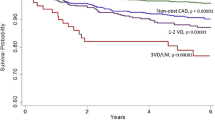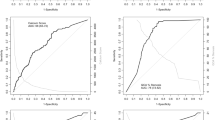Abstract
Coronary angiography remains the gold-standard method for evaluating coronary artery disease and interventional treatments. As percutaneous coronary interventions have advanced, quantitative coronary angiography (QCA) techniques have also evolved in order to provide more accurate assessments of these therapies. Improvements have been made at each step of the QCA process from image acquisition to vessel analysis. In addition, multiple scoring systems have been developed in order to utilize QCA data, both alone and in conjunction with clinical factors, to better stratify patient risk. This article will review the recent advancements in QCA techniques and outcome prediction models.
Similar content being viewed by others
References
DeRouen TA, Murray JA, Owen W (1977) Variability in the analysis of coronary arteriograms. Circulation 55:324–328
Katritsis D, Lythall DA, Cooper IC, Crowther A, Webb-Peploe MM (1988) Assessment of coronary angioplasty: comparison of visual assessment, hand-held caliper measurement and automated digital quantitation. Cathet Cardiovasc Diagn 15:237–242
Fisher LD, Judkins MP, Lesperance J et al (1982) Reproducibility of coronary arteriographic reading in the coronary artery surgery study (CASS). Cathet Cardiovasc Diagn 8:565–575
Fleming RM, Kirkeeide RL, Smalling RW, Gould KL (1991) Patterns in visual interpretation of coronary arteriograms as detected by quantitative coronary arteriography. J Am Coll Cardiol 18:945–951
Bertrand ME, Lablanche JM, Bauters C, Leroy F, Mac Fadden E (1993) Discordant results of visual and quantitative estimates of stenosis severity before and after coronary angioplasty. Cathet Cardiovasc Diagn 28:1–6
Desmet W, Willems J, Van Lierde J, Piessens J (1994) Discrepancy between visual estimation and computer-assisted measurement of lesion severity before and after coronary angioplasty. Cathet Cardiovasc Diagn 31:192–198
Kalbfleisch SJ, McGillem MJ, Pinto IM, Kavanaugh KM, DeBoe SF, Mancini GB (1990) Comparison of automated quantitative coronary angiography with caliper measurements of percent diameter stenosis. Am J Cardiol 65:1181–1184
Mancini GB, Simon SB, McGillem MJ, LeFree MT, Friedman HZ, Vogel RA (1987) Automated quantitative coronary arteriography: morphologic and physiologic validation in vivo of a rapid digital angiographic method. Circulation 75:452–460
Reiber JH, Serruys PW, Kooijman CJ et al (1985) Assessment of short-, medium-, and long-term variations in arterial dimensions from computer-assisted quantitation of coronary cineangiograms. Circulation 71:280–288
Spears JR, Sandor T, Als AV et al (1983) Computerized image analysis for quantitative measurement of vessel diameter from cineangiograms. Circulation 68:453–461
Herrington DM, Siebes M, Walford GD (1993) Sources of error in quantitative coronary angiography. Cathet Cardiovasc Diagn 29:314–321
Hausleiter J, Jost S, Nolte CW et al (1997) Comparative in vitro validation of eight first- and second-generation quantitative coronary angiography systems. Coron Artery Dis 8:83–90
Van Herck PL, Gavit L, Gorissen P et al (2004) Quantitative coronary arteriography on digital flat-panel system. Catheter Cardiovasc Interv 63:192–200
van der Zwet PM, Reiber JH (1994) A new approach for the quantification of complex lesion morphology: the gradient field transform; basic principles and validation results. J Am Coll Cardiol 24:216–224
Gradaus R, Mathies K, Breithardt G, Bocker D (2006) Clinical assessment of a new real time 3D quantitative coronary angiography system: evaluation in stented vessel segments. Catheter Cardiovasc Interv 68:44–49
Ramcharitar S, Daeman J, Patterson M et al (2008) First direct in vivo comparison of two commercially available three-dimensional quantitative coronary angiography systems. Catheter Cardiovasc Interv 71:44–50
Dvir D, Marom H, Guetta V, Kornowski R (2005) Three-dimensional coronary reconstruction from routine single-plane coronary angiograms: in vivo quantitative validation. Int J Cardiovasc Intervent 7:141–145
Agostoni P, Biondi-Zoccai G, Van Langenhove G et al (2008) Comparison of assessment of native coronary arteries by standard versus three-dimensional coronary angiography. Am J Cardiol 102:272–279
Schuurbiers JC, Lopez NG, Ligthart J et al (2009) In vivo validation of CAAS QCA-3D coronary reconstruction using fusion of angiography and intravascular ultrasound (ANGUS). Catheter Cardiovasc Interv 73:620–626
Tsuchida K, van der Giessen WJ, Patterson M et al (2007) In vivo validation of a novel three-dimensional quantitative coronary angiography system (CardiOp-B): comparison with a conventional two-dimensional system (CAAS II) and with special reference to optical coherence tomography. EuroIntervention 3:100–108
Meerkin D, Marom H, Cohen-Biton O, Einav S (2010) Three-dimensional vessel analyses provide more accurate length estimations than the gold standard QCA. J Interv Cardiol 23:152–159
Wellnhofer E, Wahle A, Mugaragu I, Gross J, Oswald H, Fleck E (1999) Validation of an accurate method for three-dimensional reconstruction and quantitative assessment of volumes, lengths and diameters of coronary vascular branches and segments from biplane angiographic projections. Int J Card Imaging 15:339–353 discussion 355–356
Tu S, Koning G, Jukema W, Reiber JH (2010) Assessment of obstruction length and optimal viewing angle from biplane X-ray angiograms. Int J Cardiovasc Imaging 26:5–17
Pocock SJ, Lansky AJ, Mehran R et al (2008) Angiographic surrogate end points in drug-eluting stent trials: a systematic evaluation based on individual patient data from 11 randomized, controlled trials. J Am Coll Cardiol 51:23–32
Mercado N, Boersma E, Wijns W et al (2001) Clinical and quantitative coronary angiographic predictors of coronary restenosis: a comparative analysis from the balloon-to-stent era. J Am Coll Cardiol 38:645–652
Dauerman HL, Higgins PJ, Sparano AM et al (1998) Mechanical debulking versus balloon angioplasty for the treatment of true bifurcation lesions. J Am Coll Cardiol 32:1845–1852
Kandzari DE, Tcheng JE, Gersh BJ et al (2006) Relationship between infarct artery location, epicardial flow, and myocardial perfusion after primary percutaneous revascularization in acute myocardial infarction. Am Heart J 151:1288–1295
Dash H, Johnson RA, Dinsmore RE, Harthorne JW (1977) Cardiomyopathic syndrome due to coronary artery disease. I: relation to angiographic extent of coronary disease and to remote myocardial infarction. Br Heart J 39:733–739
Califf RM, Phillips HR 3rd, Hindman MC et al (1985) Prognostic value of a coronary artery jeopardy score. J Am Coll Cardiol 5:1055–1063
Alderman E, Stadius M (1992) The angiographic definitions of the Bypass Angioplasty Revascularization Investigation. Coron Artery Dis 3:1189–1207
National Heart, Lung, and Blood Institute Coronary Artery Surgery Study (1981) A multicenter comparison of the effects of randomized medical and surgical treatment of mildly symptomatic patients with coronary artery disease, and a registry of consecutive patients undergoing coronary angiography. Circulation 63:I1–I81
Graham MM, Faris PD, Ghali WA et al (2001) Validation of three myocardial jeopardy scores in a population-based cardiac catheterization cohort. Am Heart J 142:254–261
Sianos G, Morel MA, Kappetein AP et al (2005) The SYNTAX score: an angiographic tool grading the complexity of coronary artery disease. EuroIntervention 1:219–227
Serruys PW, Onuma Y, Garg S et al (2009) Assessment of the SYNTAX score in the syntax study. EuroIntervention 5:50–56
Valgimigli M, Serruys PW, Tsuchida K et al (2007) Cyphering the complexity of coronary artery disease using the syntax score to predict clinical outcome in patients with three-vessel lumen obstruction undergoing percutaneous coronary intervention. Am J Cardiol 99:1072–1081
Capodanno D, Di Salvo ME, Cincotta G, Miano M, Tamburino C (2009) Usefulness of the SYNTAX score for predicting clinical outcome after percutaneous coronary intervention of unprotected left main coronary artery disease. Circ Cardiovasc Interv 2:302–308
Kim YH, Park DW, Kim WJ et al (2010) Validation of SYNTAX (Synergy between PCI with taxus and cardiac surgery) score for prediction of outcomes after unprotected left main coronary revascularization. JACC Cardiovasc Interv 3:612–623
Weintraub WS, Kosinski AS, Brown CL III, King SB III (1993) Can restenosis after coronary angioplasty be predicted from clinical variables? J Am Coll Cardiol 21:6–14
Kernis SJ, Harjai KJ, Stone GW et al (2003) The incidence, predictors, and outcomes of early reinfarction after primary angioplasty for acute myocardial infarction. J Am Coll Cardiol 42:1173–1177
Nienhuis MB, Ottervanger JP, Dambrink JH et al (2009) Comparative predictive value of infarct location, peak CK, and ejection fraction after primary PCI for ST elevation myocardial infarction. Coron Artery Dis 20:9–14
De Luca G, Ernst N, Van’t Hof AW et al (2006) Predictors and clinical implications of early reinfarction after primary angioplasty for ST-segment elevation myocardial infarction. Am Heart J 151:1256–1259
Antman EM, Cohen M, Bernink PJ et al (2000) The TIMI risk score for unstable angina/non-ST elevation MI: a method for prognostication and therapeutic decision making. Jama 284:835–842
Eagle KA, Lim MJ, Dabbous OH et al (2004) A validated prediction model for all forms of acute coronary syndrome: estimating the risk of 6-month postdischarge death in an international registry. JAMA 291:2727–2733
Lansky AJ, Goto K, Cristea E et al (2010) Clinical and angiographic predictors of short- and long-term ischemic events in acute coronary syndromes: results from the Acute Catheterization and Urgent Intervention Triage strategY (ACUITY) trial. Circ Cardiovasc Interv 3:308–316
Hamburger JN, Walsh SJ, Khurana R et al (2009) Percutaneous coronary intervention and 30-day mortality: the British Columbia PCI risk score. Catheter Cardiovasc Interv 74:377–385
Garg S, Sarno G, Garcia-Garcia HM et al (2010) A new tool for the risk stratification of patients with complex coronary artery disease: the clinical SYNTAX score. Circ Cardiovasc Interv 3:317–326
Ranucci M, Castelvecchio S, Menicanti L, Frigiola A, Pelissero G (2009) Risk of assessing mortality risk in elective cardiac operations: age, creatinine, ejection fraction, and the law of parsimony. Circulation 119:3053–3061
Chen SL, Chen JP, Mintz G et al (2010) Comparison between the NERS (New Risk Stratification) score and the SYNTAX (Synergy between percutaneous coronary intervention with taxus and cardiac surgery) score in outcome prediction for unprotected left main stenting. JACC Cardiovasc Interv 3:632–641
Conflict of intrest
None.
Author information
Authors and Affiliations
Corresponding author
Rights and permissions
About this article
Cite this article
Ng, V.G., Lansky, A.J. Novel QCA methodologies and angiographic scores. Int J Cardiovasc Imaging 27, 157–165 (2011). https://doi.org/10.1007/s10554-010-9787-9
Received:
Accepted:
Published:
Issue Date:
DOI: https://doi.org/10.1007/s10554-010-9787-9




